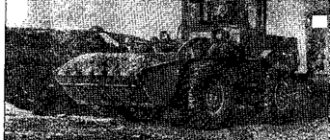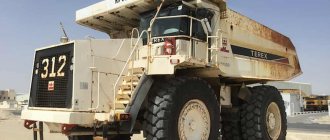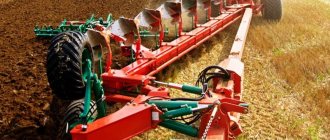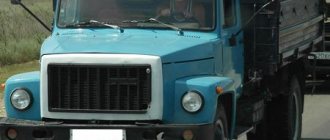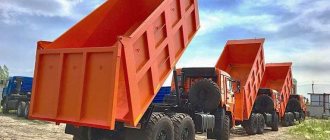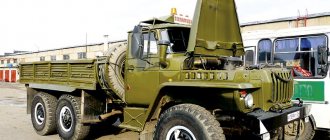A trailed scraper is a specialized equipment capable of performing excavation work and delivering soil removed from the site to the dumping site. These machines also level and compact the soil in the event area. Trailed scrapers, unlike self-propelled ones, can only be used in conjunction with a tractor or tractor. The full cycle of operation of the equipment combines the processes of layer-by-layer cutting of soil, accumulation of soil in a special bucket, transportation, unloading and return. The range of rock movement for machines of this type is 0.5…1 km. Their use is considered most effective in areas with sandy and loamy soils. Also, the trailed scraper copes well with processing soil of categories 1–4, including heavy clay, black soil and rock.
Scraper, types and types, its working equipment, application and characteristics.
A scraper is a wheeled machine having an open bucket with a cutting edge located between the front and rear wheels, which cuts, picks up, transports, unloads and distributes material while moving forward.
Scraper
Types and Types of Scrapers
Advantages of the scraper
Working and auxiliary equipment of the scraper
Scraper parameters
Application of scraper
Other road construction equipment: asphalt paver, bulldozer, grader, scraper
Key Specifications
When choosing a towed scraper, the volume and specifics of the planned excavation work, as well as the features of the local topography and the properties of the cultivated soil, should be taken into account. The main parameters of a trailed scraper are:
- type of base tractor or tractor,
- power and towing class,
- maximum speed,
- bucket capacity,
- load capacity,
- soil cutting width,
- thickness of the filling layer,
- knife depth level,
- general dimensions,
- Curb weight.
Scraper:
A scraper is a wheeled machine having an open bucket with a cutting edge located between the front and rear wheels, which cuts, picks up, transports, unloads and distributes material while moving forward.
A scraper is one of the types of earth-moving and transport mechanical equipment. The task of this machine is layer-by-layer (horizontal) cutting of soil, its subsequent transportation and dumping into designated and pre-prepared structures. The last requirement can also be met with parameters that take into account layer-by-layer backfilling.
One of the main advantages of the scraper is the fact that its use does not require the use of additional equipment - load compaction machines, tractors, etc. when moving, their dense wheels are capable of compacting the poured layer of soil.
Scraper or scraper is the name of the machine, derived from the English “scrape” - scrape. The scraper is designed for use on any type of soil (type I-III) from soft, pliable black soil to heavy clay. In the presence of particularly dense layers (various rocks, etc.), preliminary soil treatment with rippers is required.
The feasibility of using mechanisms also takes into account the range of transportation of cut soils. Thus, the ideal distance for a scraper in a unit with a basic crawler tractor is considered to be a distance from 100 to 800 meters, the maximum being 1 kilometer. This is explained by the fact that the speed of the tractor depends on the capacity of the scraper - the larger it is, the faster it can move. However, at long distances exceeding 1000 meters, it is more profitable (from a financial point of view) to use dump trucks, into which soil is loaded with excavators. If it is necessary to transport soil over a distance not exceeding 100 meters, it is more cost-effective to use classic bulldozers.
When transporting soil over a distance of 300 to 3000 meters, it is also preferable to use scrapers in conjunction with basic, high-speed wheeled tractors, but much depends on the conditions in which the machine will move. Thus, the scraper will overcome uneven ground conditions, including off-road conditions, with less effort than a dump truck.
How to make a cleaning tool with your own hands?
You can make a scraper yourself. It is constructed from dense plywood with a thickness of at least 5 mm, or from wooden beams. The basis for the ladle can be an old plastic barrel or tray.
The handle, made of wooden slats, is attached to self-tapping screws . To strengthen the working surface, use a strip of galvanized steel. If you have a welding machine, you can make a metal scraper.
The video will show you how to make a snow scraper with your own hands:
Types and types of scrapers:
There are a lot of types and types of these earthmoving and transport machines. Their main difference is:
– types of installed main and auxiliary equipment;
– parameters of the latter;
– methods of loading and unloading;
– nuances of movement and control.
The choice of scraper directly depends on the conditions in which it is planned to be used.
The main difference between scrapers is the method of movement. Distinguish :
– trailed scrapers. Made in a unit with a caterpillar tractor and have two axles to which the weight of the machine itself and the contents of the bucket when filled are transferred;
– semi-trailer scrapers. The design involves aggregation with a wheeled tractor with one axle. With the help of a drawbar, half of their mass is distributed onto the axle of the tractor itself.
In turn, trailed scrapers are divided into types :
– based on a caterpillar tractor;
– based on a wheeled tractor (tractor).
According to the type of loading , scrapers are:
– using traction forces of the base load (conventional scrapers);
– using an elevator (elevator, row, rotary).
According to the rotation control system, scrapers are divided into scrapers:
– with rotation of a single-axle tractor;
– with rotation of a two-axle tractor (with rotation of the front steered wheels).
Based on the number of axes, scrapers are divided into:
– biaxial scrapers designed on the basis of a single-axle tractor;
– three-axle (semi-trailer) scrapers based on a tractor with two axles.
Based on the number of engines, scrapers with one or two motors are distinguished.
According to the drive system, scrapers are divided into machines with:
– front drive wheels;
– with medium driving wheels;
– front and middle drive wheels;
– all driving wheels.
Also, when choosing a scraper, additional parameters are taken into account, for example, the capacity of the bucket. Bucket capacity (measured in cubic meters) can be:
– small – no more than 5;
– average – from 5 to 15;
– large – over 15.
The most popular is the medium volume.
Depending on the method of unloading soil from a bucket, there are scrapers with:
– tilting the soil forward or backward;
– forward sliding rear wall of the bucket;
– tilting bottom and forward sliding rear wall.
according to the type of control of working equipment :
– rope;
– hydraulic;
– with electrical control.
The most popular are scrapers equipped with a hydraulic control system, because... allow the reversal of existing forces.
Purpose
Scrapers are used to develop soil of categories I–III – from chernozem to clay. It could also be a rock mass. In this case, scrapers with a coal bucket are used. Another use case is the development of subsoil for the purpose of mining.
Directly involved in the work is a bucket with a front cutting edge, which is mounted on a frame. Using a drawbar, it is attached to a crawler tractor or pneumatic tractor, although self-propelled models are also available.
As the bucket descends, it cuts into the ground with its thin leading edge. As he moves, he cuts it off in thin layers one by one. Thus, the ladle is gradually filled and closed with a special valve. This is followed by transportation of the soil and its unloading, after which the scraper returns to the development site.
The optimal way to move the machine is along an elliptical path or “figure of eight”. The operator periodically (at his own discretion) changes the direction of movement to the opposite direction. This is done in order to eliminate one-sided wear of the running parts.
Working and auxiliary equipment of the scraper:
The working equipment of the scraper includes the following components:
– ladle;
– mechanism that controls the damper and bucket;
– chassis.
A bucket is a working container designed to place layers of soil into it, which the scraper develops. Additionally, it serves as a supporting frame, where part of the load from its mass, the soil itself and traction force is distributed. In the front part it rests on the axle and traction frame, and in the rear part it rests on the wheel axle shafts. Essentially, a bucket is a welded structure consisting of:
– side walls;
– bottoms;
– buffer frame.
The front wall of the bucket is a damper, whose task is to regulate the height of the loading slot during the process of collecting soil into the bucket. The soil is pushed out of the bucket using a rear moving wall equipped with a pusher and rollers. Hydraulic cylinders and a lever mechanism are used to control the bucket and damper.
The chassis consists of completely unified front and rear wheels mounted on axles and axle shafts.
Scraper accessories:
– pusher tractor . A pusher tractor is necessary when working on hard soils and rocks, as well as when operating powerful earth-moving and transport mechanisms, when the traction force of a tractor-tractor alone is not enough;
– tractor-tractor;
- ripper . Rippers perform preliminary loosening of the soil, which facilitates its further cutting with the scraper itself.
All types of auxiliary equipment can significantly improve the performance characteristics of the main machine and extend their service life.
How to use?
Using the snow slider is very simple.
To do this, perform the following steps:
- lower the product onto the track;
- load snow with a bucket, pushing it forward;
- lower the handle and drag the snow to the storage location - preferably to the side of the road or into a ditch;
- if there is a curb on the path of movement, then first, using the same scraper, they make an exit along which the obstacle is bypassed.
After completion of the work, the surface of the engine is cleaned of snow and adhering dirt, wiped with a dry cloth and stored.
Advantages of the scraper:
Like any mechanism, earthmoving and transport equipment has its advantages over other similar machines. So, the scraper has:
- cyclicality. One ongoing operation consists of many important components: cutting off the formation and its subsequent excavation; loading, laying and compacting soil;
– thin-layer cut. The ability to cut layers of small height allows you to mechanize small planning work according to pre-established parameters;
– layer-by-layer filling of cut soil. This feature is relevant when equipping dams, dikes, embankments, etc.;
– automatic compaction of poured layers. Simultaneous laying and compaction of soil with powerful scraper wheels allows you to abandon the use of other equipment designed for this work;
– reduction of production costs for soil development, its transportation and subsequent laying. These tasks are performed by one machine, so you can refuse to use additional equipment;
– versatility. Scrapers are used in many branches of the mining industry, road and other construction and at different stages of work;
– high speed parameters. Despite the size of the equipment, even a fully loaded scraper can reach speeds of up to 50 km/h;
– no difficulties with repairs. All mechanical components of the equipment are distinguished by high maintainability parameters.
Links
Wiktionary has an entry for "scraper"
Lifting and installation Crane | Noria For working with concrete Concrete mixer | Concrete pump | Vibration compactor For working with road surfaces Asphalt Paver | Road roller | Road milling machine Auxiliary Compressor | Loader |
Application of scraper:
The main areas of application for scrapers are various areas of the mining industry, road and other construction. Thus, in irrigation and drainage construction they are used to carry out the following work:
– development of soil in excavations. High profitability was noted in the construction of large canals, whose depth is 5-7 meters;
– creation of bulk earthen structures (dams, embankments).
In the mining industry:
– carrying out stripping operations, mining and transportation of rocks.
In road and other construction:
– preparatory work for the foundations of buildings, structures and roads;
– planning work on construction sites, irrigated and other territories, sites for road construction.
The greatest efficiency of using these earth-moving machines is observed in latitudes with a short winter period. In other climatic conditions, if soil freezing reaches 20 centimeters, the use of rippers is additionally required. The choice of a scraper for certain work is influenced by the shape and size of the future structure: the best of them are rectangular excavations or pits, without pockets or protrusions, as well as various types of embankments. The standard size of the scraper chosen to solve a specific problem is determined by preliminary economic calculations based on the volume of work.
Helpful information
Tips that will be useful to all scraper owners:
You need to select an engine for your height. The handle should be approximately at the level of the middle of the chest, otherwise it will be uncomfortable to work with the tool.- The scraper is not used for crushing ice.
- To prevent the appearance of calluses, you need to wear gloves.
- If the handle is metal, it should have linings, since in cold weather the metal becomes icy.
